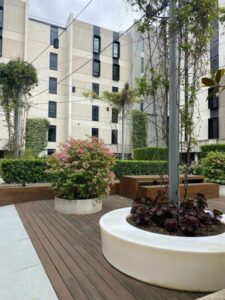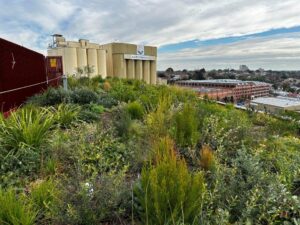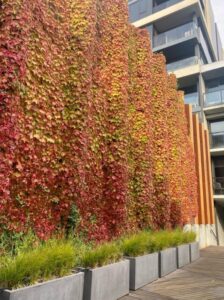
From concept to construction – easing the path to greener builds
By Michael Casey
The integration of greenery into the built environment is gaining momentum as urbanisation continues to reshape cities worldwide. The movement towards developer-led greenery inclusion is driven by the need for sustainable development, improved quality of life, and recognition of the multifaceted benefits that green spaces provide. As cities increasingly acknowledge the significance of greenery in urban development and the myriad benefits it brings, it is timely to highlight evolving Australian policies and the challenges developers face. Additionally, it is important to showcase the successful strategies developers are employing to incorporate green spaces into urban landscapes.
Greenery plays a crucial role in maintaining environmental balance within urban areas. Plants and trees act as natural air filters, absorbing pollutants and releasing oxygen, thereby improving air quality. Urban green spaces also contribute to temperature regulation through evapotranspiration, which cools the air and reduces the urban heat island effect – a common phenomenon where urban areas are significantly warmer than their rural surroundings due to human activities. Green spaces have profound social and health implications, providing areas for recreation, relaxation, and social interaction, which are essential for the mental and physical well-being of urban residents.
Incorporating greenery into urban development can also lead to economic benefits, especially with regard to properties where nearby green spaces often have a heightened effect on market values, attracting more buyers and tenants. Businesses located in green environments can experience increased foot traffic and customer satisfaction. Additionally, green spaces can enhance tourism, drawing visitors to aesthetically pleasing and environmentally friendly urban areas.
Despite the many benefits noted and recognised by councils, developers, and the public alike, why are we not seeing a rise in greenery added to new and old buildings in and around our built environments? One of the primary challenges developers face is the limited availability of space in densely populated urban areas, with high land costs further complicating the inclusion of extensive green spaces. Developers must also find innovative solutions to incorporate greenery without compromising valuable real estate. Developers have been quick to alter their visual marketing of development sites by incorporating images of greenspaces into their sales. However, artists’ renderings have often been questioned for not providing the full picture of the future outcomes of greenery inclusion, along with the costs and management requirements of these assets.
The maintenance of green spaces requires ongoing investment and effort. Developers and city planners must ensure that these spaces are sustainable in the long term, with adequate resources allocated for their upkeep. This includes considerations for irrigation, pruning, pest control, and soil health, and the use of professionals trained in working with landscapes on structures. Working at heights, specialist machinery use, and a deep knowledge of plants all equate to high costs when professionals in these fields are required for upkeep and ensuring the developer keeps their contracted promise of safeguarding greenery upon the build’s completion.

What motivates developers to incorporate greenery into their buildings? While the benefits can enhance sales initiatives, navigating the regulatory landscape presents significant challenges. Zoning laws, building codes, and other regulations often restrict the type and extent of greenery that can be included in a development project. Obtaining the necessary permits and ensuring compliance with environmental standards requires careful planning and collaboration with local authorities. Developers must also consider the underlying reasons for including green spaces, addressing the fundamental question of why this inclusion is necessary. While the incorporation of public parks, community gardens, green infrastructure, sustainable design, and green roofs and walls are all valuable inclusions, they must be carefully and thoughtfully included for the right reasons, not just for aesthetic appeal.
Government policies and incentives play a critical role in encouraging developers to include greenery in their projects. Tax incentives, grants, and subsidies for green building practices can offset some of the costs associated with creating and maintaining green spaces. Additionally, clear guidelines and standards for green development help ensure consistency and quality across projects. The City of Melbourne has developed their Green Factor Tool, a green infrastructure assessment tool designed to aid in the design and construction of new buildings and significant alterations that are environmentally friendly and incorporate green infrastructure. This online tool helps landscape designers, architects, planners, and developers benchmark and enhance the effectiveness of their green designs for proposed developments. The goal is to increase vegetation cover on private land in Melbourne, and it has also been picked up by Brisbane City Council, who are detailing their own version of the Green Factor Tool.

Recently, the City of Melbourne passed Amendment C376 (Sustainable Building Design Amendment), which proposes changes to the planning rules to ensure future development achieves best practices in environmentally sustainable design. This includes increasing energy efficiency and incorporating more greening into buildings. Amendment C376 and the Green Factor Tool are two key initiatives by the City of Melbourne to facilitate the inclusion of green infrastructure in buildings. These measures underscore the requirement for developers to incorporate environmentally sustainable practices and enhance vegetation cover in their projects, promoting a greener and more sustainable urban environment.
A recent example of the Green Factor Tool being used by a developer is a newly built office complex in the north of Melbourne. “The Bruce” was constructed as a commercial office space in the heart of a commercially zoned sector of Melbourne. The inclusion of a biodiversity green roof, façade tree plantings, and lower landscape gardens utilised the Green Factor Tool to demonstrate how this building integrates sustainably with its surrounding environment. The developer, Medley Property Group along with Carr Architect, worked with the City of Melbourne to develop a building that incorporated maximum greenery while blending into the surrounding environment. A nature corridor created between the local waterway and the building roof space ensures an easy pathway for wildlife to move freely into and onto the building itself. The biodiversity roof lives up to its name by providing a safe haven for birds and insects while offering a green visual for surrounding residents who call this suburb home.
The City of Sydney has recently released their Greening City Strategy, which will also look at developing a Green Factor Tool to assist in evaluating and quantifying the amount and quality of urban greening in a project. The Greening Sydney Strategy assists developers in incorporating greenery into their build by providing clear guidelines, tools, and incentives that align with the city’s sustainability goals. The strategy offers regulatory support by setting clear regulations and standards for urban greening, and helps developers navigate the complex regulatory landscape, including zoning laws and building codes that support the inclusion of green spaces in new developments. Various incentives and grants encourage developers to include green infrastructure, offsetting the costs associated with implementing sustainable practices and green elements in buildings. Additionally, the strategy fosters collaboration and partnerships, offering technical assistance and tools, such as the Green Factor Tool, to help developers assess and improve the environmental performance of their projects.
Developer-led greenery inclusion in the built environment is a multifaceted approach that offers numerous benefits, from environmental sustainability and improved public health to economic gains and enhanced quality of life. Despite the challenges of limited space, high costs, and regulatory hurdles, innovative strategies such as vertical gardens, green roofs, and mixed-use developments provide effective solutions. Successful case studies from around the world demonstrate the feasibility and advantages of integrating greenery into urban landscapes.
Evolving policy frameworks that prioritise sustainability and green infrastructure increasingly facilitate this movement. These policies streamline regulatory processes, offer incentives for green building practices, and encourage collaboration between developers and local authorities. By leveraging government policies, community engagement, and sustainable design principles, developers can create vibrant, livable cities that harmonise built and natural environments, contributing to enhanced urban livability and environmental resilience.
Michael Casey
Director of Evergreen Infrastructure,
Consultant and advisor to the green infrastructure industry
Technical Panel for the AIPH World Green Cities Awards 2024
E: michael@evergreeninfrastructure.com.au
